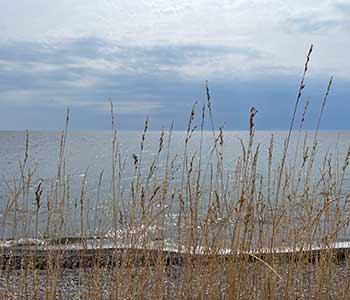
Natural beach as far as the eye can see
I've just been back to Denmark. And as is usually the case, I was more drawn out into nature by the sea than to the chic restaurants in Copenhagen. Because the northern sea has a very special appeal for me. This is due to the light, the vegetation and, above all, the fact that the beaches are completely unspoilt and clean.
August 2024
The heat and sultriness in Vienna recently prompted me to spontaneously escape to Denmark. Happy as I was, I was able to join my friend and spend a few days with her on the beautiful Baltic islands of Langeland and Lolland in the South Funen Archipelago. I realised once again how different the Nordic beaches are from those in the Mediterranean. They are unspoilt, never overcrowded and remarkably clean. This is due to a combination of strict building regulations and a strong environmental awareness among the population.
Strict building regulations for coastal protection. In Denmark, no buildings may be erected within 300 metres of the coast in order to preserve nature and prevent erosion. Similar rules also apply in Sweden and Norway, which helps to ensure that the Nordic beaches remain largely unspoilt. As there are no kiosks or bars directly on the beaches, just a few scattered ones a little further up, there is little reason for tourists to visit.
Environmental awareness of the population. Another important element for the cleanliness of the beaches is the high environmental awareness and sense of responsibility of the Scandinavians. People dispose of washed-up rubbish themselves without waiting for the public sector. If you find a plastic bag, you simply take it with you and throw it in the nearest waste bin. Incidentally, there are well-maintained public toilets everywhere in the car parks, even near the beach. So you won't come across human waste and bad odours anywhere.
Threats to the coasts from climate change. Climate change poses a growing threat to the Scandinavian coasts, as it does everywhere else. In Denmark, the sea level has risen by around 20 centimetres since 1900 and could rise by up to 1.35 metres by 2100. This leads to increased coastal erosion and more frequent storms. In some places, there are masses of uprooted trees on the beaches. To counteract this, protective measures such as the laying of stone walls have been taken on many vulnerable stretches of coast. These are intended to break the waves and stabilise the coast. In addition, sand is being piled up to reinforce the beaches. To draw attention to the dangerous rise in sea level, 1.35 metre high park benches have been installed in some places in Denmark as an art project to illustrate this.
Lived enjoyment. Of course, this is never neglected, even if my beloved Nordic cuisine is never the direct reason for my trips to the north. I particularly love the Danish smørrebrød with its various delicious herring varieties. This year, among other places, I enjoyed it at Brasseriet on Lolland in the former stables of a castle. The farm-to-table concept is alive and well, the fields are on the doorstep, the delicious salmon comes from the Faroe Islands and is smoked by friends of the house. The small crabs are hand-peeled and the beers come from their own brewery. Not a Michelin-starred establishment, simply good and relaxed. Worth a visit, just like the beautiful islands in the region.




